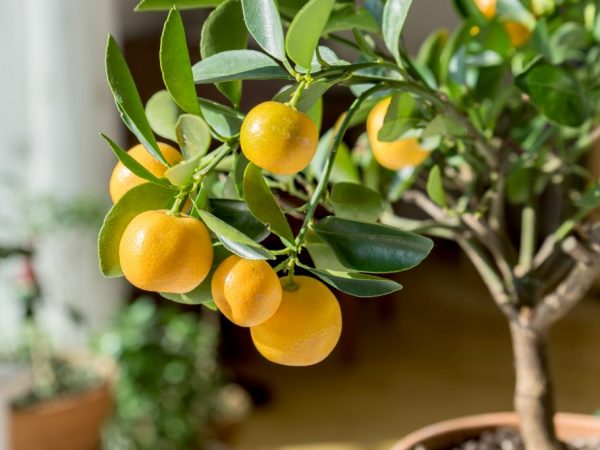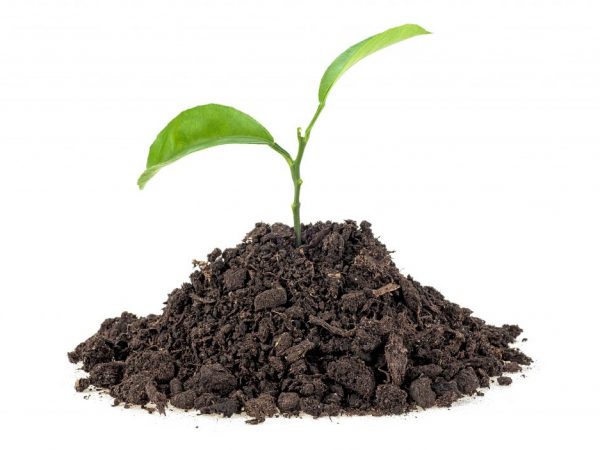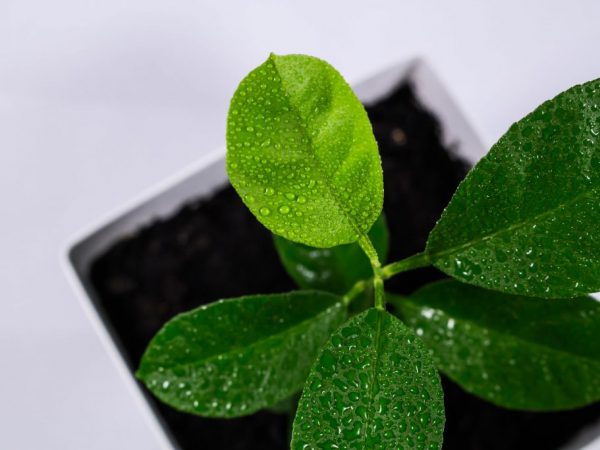Features of growing indoor citrus
Growing indoor citrus plants is easy. To get the beautiful fruits of exotic crops, take into account that in nature they grow in subtropical and tropical climates. Similar conditions should be created at home, then the result will not be long in coming.

Features of growing indoor citrus
Types of indoor citrus fruits
In the conditions of apartments, there is often a lack of light. The most shade-tolerant representatives of the citrus family are citron and lemon. They are most commonly grown at home. In addition to these crops, you can see other plants that love the sun on the windowsills:
- mandarin;
- fortunella;
- grapefruit;
- pomelo.
Some citrus fruits tend to grow unevenly. For some time they are actively developing, then a period of dormancy begins: all processes are suspended, the wood matures. After that, the plant begins to form new shoots and leaves again.
Often these crops bloom and bear fruit several times a year. The flowers are bisexual, self-pollinating in many species. To promote the formation of ovaries, they use the technique of artificial pollination with a brush. The fruits ripen for 5-9 months.
Citrus trees at home look especially impressive during flowering, when they already have fruit. Cultures are kept in a winter garden or on a windowsill.
Optimal growing conditions
Growing citrus fruits requires providing them with an appropriate microclimate.
Temperature regime
In order for the plants to thrive, they are supplied with heat. Optimal performance should be at the following level:
- 18-26 ° С in summer;
- 12-16 ° C in winter.
It is strictly forbidden to keep fruit trees at low temperatures.
Be sure to monitor that the temperature indicators for the crown and root system are at the same level. If the roots are in cooler ground, they have no time to consume water. Otherwise, the moisture saturation will be too high.
It is taken into account that keeping indoor citrus plants on the floor requires the installation of a special stand: below the temperature is always lower. It is provided if a floor heating system is installed in the room to prevent overheating.
In spring and summer, tree pots are taken out to the balcony or garden. They develop well there. Indoor citrus plants shade, since direct sunlight tends to overheat the soil, then the roots get burned. They are returned to their original place in the fall. But it is not too late, so that a sharp change in conditions does not happen, otherwise the leaves will begin to fall off.
Illumination
Light-loving cultures. The best place for them is southeast or southwest windows. At lunchtime, the trees are shaded. In the cold season, they are supplemented with daylight lamps or phytolamps.Daylight hours should be 12 hours. Longer lighting prevents citrus indoor plants from developing properly.
Air humidity

Spray the plants regularly
Trees naturally grow in an environment with high levels of humidity. Indoors, they are increased by spraying the leaves. A household humidifier is also used.
Care
To grow citrus fruits efficiently at home, certain rules must be followed.
Watering
The soil is often moistened, but moderately. Citrus crops are not drought tolerant, but they should not be watered too much either.
Water is brought in, observing the following recommendations:
- in winter and summer, the ground should always be moist;
- between waterings, the topsoil must dry out;
- water should flow out of the drainage holes: this indicates its access to all parts of the root system.
The frequency of watering depends on the season, the structure of the soil, its volume, and the size of the citrus trees. In summer, the earth is moistened more often, every day. In winter - every 7-10 days. They take warm, settled water. Make sure that its temperature during winter care is not too high, otherwise the citrus will wake up prematurely.
The liquid should be soft. If it is tough, soften by boiling. Some growers acidify water with lemon juice (1-3 drops per 1 liter).
Top dressing
Caring for citrus plants at home includes fertilizing. Top dressing is carried out during the period of active growth from mid-February to mid-September. Trees especially need nutrients in the spring, before flowering. During this period, they are watered with a solution of mineral fertilizers 1-2 times a week. The dosage is observed strictly according to the instructions, because if it is exceeded, the root system will receive burns.
Top dressing is not performed in such cases:
- plants are dormant;
- leaves fall;
- 2 months have not passed after the purchase.
For better assimilation of fertilizers, microbiological preparations "Vostok-EM1", "Baikal", "Vozrozhdenie" are regularly introduced.
Transfer
Citrus plants are transplanted at home only when necessary, since they do not tolerate the procedure well. After her, the trees get sick.
Soil preparation

The ground must be disinfected before use.
To make a transplant, a soil mixture is first prepared. It should include the following components:
- peat;
- turf and leafy land;
- sand;
- humus.
Suitable acidity is 5-7 units. Also on sale there is a ready-made soil called "Lemon". Before use, the earth is steamed or poured with boiling water. Thanks to these manipulations, they kill the larvae, their eggs, as well as pathogenic bacteria.
Vessel selection
The pot for indoor citrus plants is selected according to the size of the root system. A container made of unglazed fired clay, as well as tightly knit wooden tubs, will do. To remove excess moisture, holes are made in the bottom, drainage is laid. The pot is treated with a solution of potassium permanganate.
Transshipment
The procedure is performed by:
- after purchase, since citruses are planted in peat soils, which dry out quickly. First, sand and turf soil are added to them;
- once a year, if necessary, young plants are reloaded;
- once every 3-4 years - adults.
The transplant is carried out by the transshipment method. It must be neat. The roots are washed only if they are badly damaged. Trees are replanted when an earthen ball forms on the roots. The soil is changed minimally.
Large specimens should not be transplanted, as are plants with fruits and flowers. For them, only the top layer of the soil is replaced.
Crown formation
In mid-February, before the start of intensive development, the shoots are pruned. Fatty branches are also removed in summer. Different citruses differ in the way they grow:
- lemon does not branch well, it is difficult to form a beautiful crown;
- the orange is characterized by intensive development, it is shortened;
- tangerine requires pruning of the shoots growing inward, since the tree thickens strongly.
Indoor citrus plants, grown by cuttings, form immediately, from seeds - at the age of one year. If they have reached a height of 30 cm, pinch the top, then the lateral buds are activated. Then skeletal branches are formed: several are selected, the rest are removed. When they become strong, shorten.
After the crown shape is formed, annual pruning is performed. Damaged, diseased shoots are also removed. To stimulate fruiting, branches are shortened in spring and summer.
Disinfected sharp instruments are used for manipulations. The branches are cut over the bud located outside the crown. Then the new shoots will be directed not inside the plant, but away from the center of its crown.
Breeding

The best way to propagate is by cuttings.
There are several ways to propagate a homemade citrus tree. So that attempts to grow a new ornamental plant are not unsuccessful, you need to know all the subtleties of the process.
From the bone
The seeds are extracted from ripe or slightly overripe citrus. They are planted immediately in a pot with drainage, without drying. The soil mixture should contain leafy soil, coarse sand and fertile soil. The bones are sealed to a depth of 2-3 cm. The pot is covered with a plastic bag. Placed on a windowsill so that the sun falls on it. The film is regularly removed for airing.
The seeds are watered every 3 days. In winter, the greenhouse is illuminated. Seedlings appear in about a month. The timing depends on the quality of the seeds, lighting and room temperature.
Cuttings
Cutting is the best way to propagate citrus fruits at home. Cuttings are cut from healthy mature plants when they are dormant. Each twig should have 2-3 buds and a length of about 10 cm. For spring cuttings, branches of autumn growth are taken, for summer - spring ones.
The procedure is performed step by step:
- make the top cut, it should be straight;
- the second is oblique, it is produced under the bud of the lower leaf, which is removed;
- slightly scratch the bark with a needle;
- placed for some time in a root solution;
- planted in the ground, deepening to the first leaf.
Rooting cuttings is best done in a sterile mixture of peat and sand. The ambient temperature should be 25 ° C. Provide diffused light. The process lasts from 2 weeks to 2 months. Propagated by cuttings, citrus fruits develop well and bloom quickly.
Graft
The method is more often used to obtain new plants on an industrial scale, since it requires special knowledge. At home, a method is used for breeding capricious variegated species. The grafted plant inherits the desired qualities. This method also propagates crops that have a poorly developed root system. Grafting on a strong rootstock provides them with good roots.
Winter maintenance
The dormant period for citrus crops lasts from November to February. To grow a beautiful fruit tree, you must ensure that it has the correct wintering period.
Citruses need a mandatory drop in temperature during the cold season. Under natural conditions, they receive a lot of light, the amount of which in our area in winter drops sharply. Even when growing citrus fruits on a windowsill, there is not enough illumination. Without it, plants do not receive the necessary energy for photosynthesis, and at home they spend a lot of it, so the culture is depleted. This leads to her death. To prevent the problem, the illumination must be increased.
For wintering citrus, a loggia or a greenhouse, a cool apartment is suitable. If the temperature in the house is high, a pot with a tree is placed on the windowsill, fencing it off from the room with a frame. Then it will get colder there. If these conditions are not met, the culture dies in 3-4 years.
Possible problems
If the care of citrus plants at home is done incorrectly, this is manifested by a deterioration in their condition. Possible problems like this:
- Sharp jumps in temperature (7 ° C-10 ° C) threaten with leaf fall.
- The difference between the temperature of the soil and the air near the crown leads to shedding of leaves.
- With too much water absorption by the roots, dropsy develops, since the ground part of the culture does not have time to consume liquid. Growths appear below the sheet plate that cannot be eliminated. This is especially true when abundant watering is combined with low temperatures.
- Improper illumination: with a lack of light, too large and green leaves are formed, a strong deficiency is manifested by yellowing and falling foliage. If the light is too intense, the leaf plates become discolored. Direct sunlight often causes burns. This is especially common after winter, when the citrus tree weaned from the sun.
- An excess of fertilizer appears as a dry border around the leaves. Their fall begins.
- Lack of nutrients: if there is not enough nitrogen, the foliage becomes dull and turns yellow. With a deficiency of phosphorus, the flowering is weak, the leaf plates lose their gloss. When citrus fruits need potassium, grooves appear on the leaves, they fold along the central veins.
Diseases and pests
If mistakes are made in the care of indoor citrus plants, they begin to hurt or are exposed to the invasion of such pests:
- mealybug;
- shield;
- whitefly;
- aphid;
- spider mite.
It is worth regularly inspecting trees for the presence of insects, as well as for signs of their parasitism:
- sweet discharge;
- yellow dots on the leaves, below - powdery bloom;
- white lumps in sinuses, trunks and shoots.
To combat pests, plants are regularly washed under the shower. It is also worth taking proper care of them: watering moderately, adjusting the temperature and humidity of the air.
Insects are removed with a wet wipe or ash and soap solution. In extreme cases, use a drug called "Aktara" (1 g per 10 liters).
Fungal diseases rarely affect citrus fruits when kept in the house. This happens more often in greenhouses. In indoor conditions, fruit trees are affected by soot fungus, which appears as a result of the sweet secretions of insects.
Viral diseases such as mosaic cannot be cured.
Pets can also harm trees.
Conclusion
It is not difficult to grow beautiful citrus indoor plants if you know all their preferences. Providing proper care contributes to their good development. If you follow all the recommendations, after a while the culture will delight you with flowering, and then with fragrant fruits. With the correct formation of the crown, you will get an aesthetic citrus tree that will decorate the collection of every gardener.


